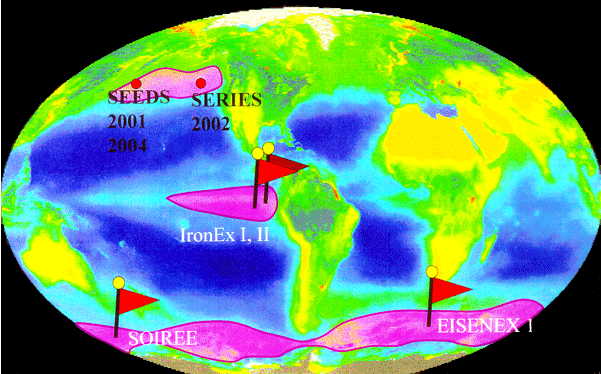
| Top Page |
| Introduction |
| Obs. Data |
| Cruise Info. |
| Activity |
| Contact |
| Links |
<< Back
Introduction

Iron limitation has been proposed as the reason for the existence of surface waters rich in macro-nutrients but low in phytoplankton biomass in the subarctic Pacific, the equatorial Pacific and the Southern Ocean. Recent in-situ iron enrichment experiments confirmed this in the equatorial Pacific and the Southern Ocean ( 1),2),3)). In the subarctic Pacific, with biology and water structure different from the other two regions, strong zonal gradients in atmospheric iron deposition existing between the eastern and western gyres, may give rise to distinct phytoplankton communities that characterize these biogeochemical provinces. Here we present an overview of SEEDS (Subarctic Pacific Iron Experiment for Ecosystem Dynamics Study), the first in situ test of the iron limitation hypothesis on natural ecosystem and geochemical cycles in the subarctic Pacific. The SEEDS 2001 was originally proposed in the Advisory Panel on Iron Fertilization Experiment (IFEP) at the PICES Eighth Annual Meeting in Vladivostok, Russia.
Reference
- Martin, J.H. et al (1994) Testing the iron hypothesis in ecosystem of the equatorial Pacific Ocean. Nature, 371: 123-129
- Coal, K.H. et al. (1996) A massive phytoplankton bloom induced by ecosystem-scale iron fertilizatioesperiment in the equatorial Pacific Ocean. Nature, 383: 495-501
- Boyd, P., A.J. Watoson, C.S. Law et al. (2000) A mesoscale phytoplankton bloom in the polar Southern Ocean stimulated by iron fertilization. Nature 407: 695-701